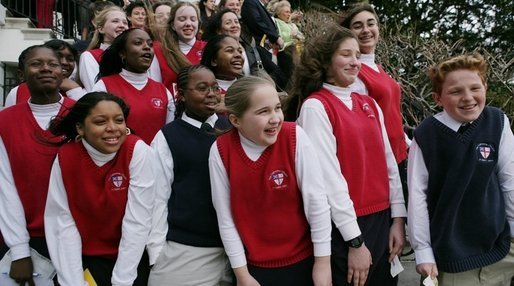 The fact that Catholic education produces solid academic results is well documented. The benefits include the following:
The fact that Catholic education produces solid academic results is well documented. The benefits include the following:
- 98% of low income, minority children graduate from Catholic high schools, compared to only 66% of all students in public schools;
- Hispanic and African American Students who attend Catholic schools are 2.5 times more likely to graduate college;
- 81% of students who graduate from Catholic schools attend college, compared to 44% of students in public schools;
- Catholic school students are also more tolerant of diverse views, more likely to vote, more likely to be civically engaged, and earn higher wages than their public school peers.
Research suggests that it is not just the students who benefit from Catholic schools. A book titled Lost Classroom, Lost Community: Catholic Schools’ Importance in Urban America, by Margaret F. Brinig and Nicole Garnett, highlights the importance of Catholic schools as community institutions.
Specifically, the book assesses the negative effects associated with Catholic school closures. The authors demonstrate statistically that after a Catholic school closes, there is a decrease in “social capital.” In other words, the web of connections and trust between neighbors is diminished. Ultimately this leads to more crime, making the neighborhood less appealing to families.
Catholic schools are good community institutions for the same reason that they are good educational institutions. The members of the school community facilitate an environment of trust and high expectations. This positive environment reaches beyond the schoolhouse and benefits the local community.
Unfortunately, we are facing a crisis in Catholic education. In the past two decades, approximately 2,000 schools have closed nationally. Many of these schools served as community anchors for generations, providing a quality education to Catholic and non-Catholic children alike. These community institutions will not easily be replaced.
Yet, there is hope. The closures are often related to decreased enrollment. This does not reflect a lack in interest among families. Many families, especially in poor urban communities, simply cannot afford the cost of tuition despite generous subsidies provided by the Church.
In order to address this problem, states from across the country are adopting school choice policies in hopes of increasing the availability of a nonpublic school education. These policies include vouchers, scholarship tax credits, and education savings accounts. These programs have made a Catholic education more affordable, particularly for low income families living in urban areas. As a result, some states have successfully turned the tide of declining enrollment and closures.
I would recommend this book to anyone who is interested in the plight of our urban communities. Understanding the value of Catholic schools is the first step towards doing something to ensure that these community institutions continue to serve students for years to come.



